Heroes Of The Great War: World War I Comes to Kickstarter [Part One]
May 1, 2017 by oriskany
Almost every wargamer has a favourite genre of the hobby, usually based on one of the fundamental advantages it holds over others. My personal favourite, of course, is historical, largely because playing the right historical wargame can actually teach you something about the real world and how it came to be shaped the way it is today.
This was certainly the case when I was asked to review “Heroes of the Great War: Limanowa 1914”. This is a board-based wargame coming to Kickstarter in May, 2017, presented by Gladiator Games.
I was excited to get a look at the game, not only because it deals with World War I, but the Eastern Front of the conflict, an under-represented field in today’s gaming market.
Heroes Of The Great War
Limanowa 1914
Heroes of the Great War: Limanowa 1914 is a hex-based, operational-level wargame. The initial box set and rules are for four players (two teams of two players each), although variants are also presented for two players, three players, solitaire, and even a full cooperative mode.
I was fortunate to get my hands on an advanced demo copy of this game and try it out several times with fellow Beasts of War members @aras and @gladesrunner. Over the course of three articles, I’ll be discussing what I thought of the game, and filling in a little background on the Battle of Limanowa and World War I in the east.
In Heroes of the Great War: Limanowa 1914, players control Austro-Hungarian or Imperial Russian army groups in one of the opening battles of World War I in the east. Each piece is a regiment, brigade, or division, so unlike most miniature games, you really are a “general” here with tens of thousands of men under your command.
Four basic operational-level formations are in play here. On the Austro-Hungarian side we have the “Hadfy Group” and the “Szurmay Group” (roughly corps-level formations named after their commanding generals). On the Imperial Russian side we have the VII and VIII Corps, commanded by Generals Orlov and Eck, respectively.
Players move their pieces across the hex-grid map board and engage in combat, seeking to wrest control of key objective cities while preventing the opponent from doing the same. There are multiple ways for players to win the game, and a wide variety of unit types whose unique abilities must be “synergized” for best results.
Again, the full review will come in three articles. But to summarize, I definitely recommend this game. Hex-based “general’s table” games ranging over hundreds of miles might not be what you’re used to, but Heroes of the Great War: Limanowa 1914 balances realism and playability to make it a great springboard into this type of system.
Battle Of Limanova
Background
One of the first things that attracted me to this project was the subject matter. Let’s face it, the historical wargame market is fairly well inundated with certain wars and conflicts. Meanwhile, we don’t see a lot of World War I games out there, and practically nothing that takes place in the Eastern European side of the conflict.
This is a shame, since (in my opinion) the Eastern European side of World War I is far more interesting than the war in Western Europe. In the west, after all, after a dazzling opening campaign in 1914, the war slowly ground to a halt and stagnated into a infamous morass of trench warfare.
While the Western Front certainly sees a lot of innovation, does it really go anywhere? Aircraft, zeppelins, chemical weapons, rapid-fire artillery, tanks, stormtroopers, flamethrowers, all are hurled into the deadlock but they never really break the stalemate.
In contrast, World War I in the East never really grinds to this entrenched halt. Looking at a map, it’s easy to see why. From north to south, the battlefront from Serbia to the Baltic is many times longer than from Switzerland to the English Channel. The armies never really ran out of room to manoeuvre.
This brings about a war that is much more fluid, with everything from cavalry lancers to locomotives maintaining a much faster tempo in which trench warfare never becomes as great a factor. This results in things actually HAPPENING in the East, up to and including the collapse of two of the theatre’s major empires.
I’m speaking of course, of the Austro-Hungarian Empire and the Russian Empire, both of which were essentially knocked out of the war by the end of 1917. But of course, such events were still far in the future during the winter of 1914, when the Battle of Limanowa took place.
World War I essentially started between the Austro-Hungarian and Russian Empires after Archduke Franz Ferdinand was assassinated in Sarajevo in June, 1914. Imperial Germany sided with the Austro-Hungarians, and through the rest of 1914 the Russian armies sustained some very heavy defeats in what is today Poland.
The Austro-Hungarians thought they could do the same, but their initial battles against the Russians went badly. Soon the Tsarist Russians were pushing through the Carpathian Mountains and into Galicia, threatening Krakow, the plains of inner Hungary, and the stability of the Habsburg dynasty.
However, the Austro-Hungarians were able to mount a last-ditch December offensive around the towns of Limanowa and Bártfa, and after a desperate two-week battle in the frozen mountainous terrain, managed to push the Russians back across the Carpathian mountains, although the Austro-Hungarians failed to retake all of Galicia.
Heroes Of The Great War
First Looks
Okay, so let’s begin our detailed look at the Heroes of the Great War: Limanowa 1914.
The first thing I noticed was the quality of the components. Although “just” a demo set, it looked very professional. In particular I was impressed by the art direction and graphic design of the board, the counters, and the various cards you get with the game.
Let’s start with the map board. The detail is lavish, yet the “functional” aspects of the board remain crystal-clear. The game effects of each type of terrain hex, the objective markers, the roads and rail lines were all very well-done, easy to read, and very engaging to look at.
All the components also have a great “Great War” look to them. The cards aren’t simply printed, they look like they’ve been typed on an old manual typewriter and signed by staff officers. Some even have “fold lines” like dispatches just unfolded from a courier’s satchel.
To take the briefest of summaries (again, we’ll be going over this in greater detail in later articles), the rules are also solid. At first, the limitations of the turn sequence might seem restrictive. You can only perform so many actions in a turn, and only rarely can a unit move and attack in the same turn (i.e., in conjunction with certain cards).
However, this is by design. Such constraints are crafted to simulate the dire limitations of 1914 logistics, transport infrastructure, communications, and mobility of the armies. This is before tanks, aircraft, or even large numbers of trucks enter the battlefield. Everything is boot- or hoof-powered, in the mountains … in winter, no less.
These rules also compel the player to think about long-range planning. Because a unit can’t move and then attack in the same turn (usually), do execute even the simplest of strikes requires at least a two-turn plan. Reserves, rail resources, and abilities listed on battle cards, all must be allocated as part of a careful strategic outlook.
Of course, we’re just getting started here. In the next two articles, we’ll look much more deeply into the rules, the components, the variants, and even go over a couple of “battle reports” where we talk in detail about the results of our actual plays of this game.
Meanwhile, I highly encourage everyone on Beasts of War with even a hint of interest in historical wargaming to check out Heroes of the Great War: Limanowa 1914 on Kickstarter. With very little in the way of “game complexity,” the game nevertheless presents you with the deep dilemmas and stark challenges faced by the World War I general.
Will you be giving this game a look on Kickstarter? What are your thoughts on this relatively unexplored “trench-less” part of World War I? Post your questions and comments below, and keep the conversation going!
If you would like to write an article for Beasts of War then please contact me at [email protected] for more information!
"...we don’t see a lot of World War I games out there, and practically nothing that takes place in the Eastern European side of the conflict"
Supported by (Turn Off)
Supported by (Turn Off)
"What are your thoughts on this relatively unexplored “trench-less” part of World War I?"
Supported by (Turn Off)









































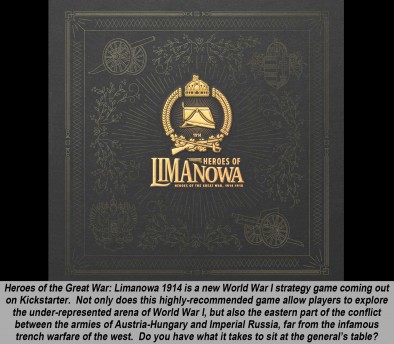
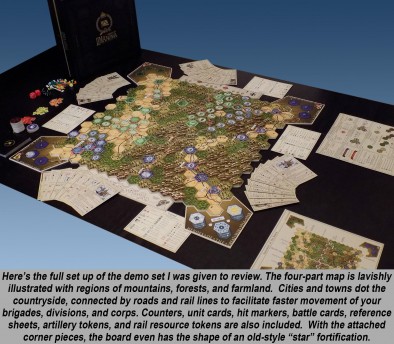
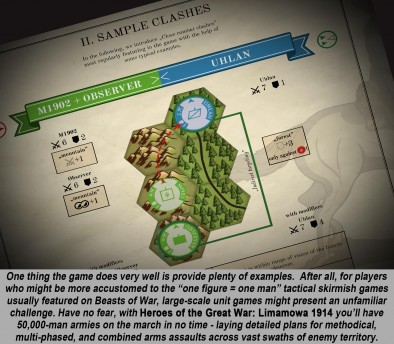
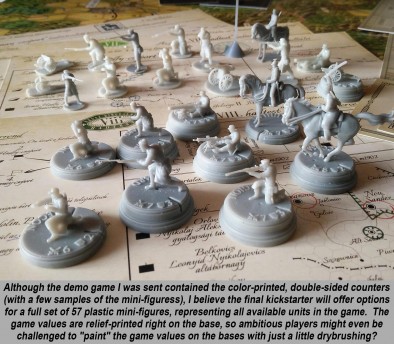
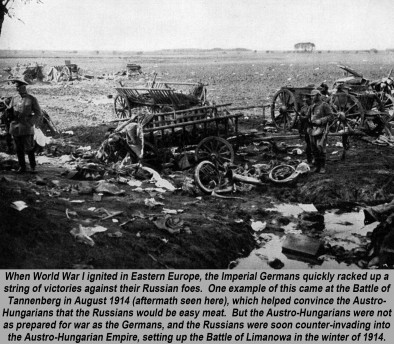
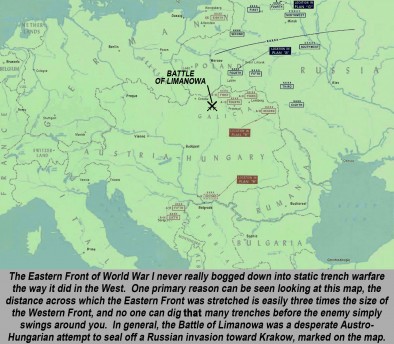
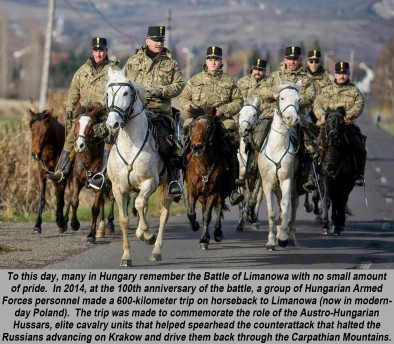
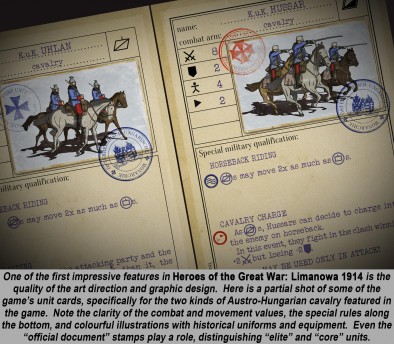



































WWI with movement?! Cool.
The Eastern Front is an area that is ignored – so good to see
Thanks for kicking us off, @rasmus . 😀 Yes, there is movements. With the rail roads, roads, and cavalry units (including Cossack and Hussar units) – sometimes rather fast movement. Sometimes not so fast, though. This was a World War I battle . . . where practically everything was leg-powered (either two legs or four) . . . . . . in the mountains. . . . in winter. 😀 I fully agree about World War I in general not getting enough press in wargaming, especially the Eastern Front. Hell, even the desert campaigns in World War I have been… Read more »
This was cancelled on Kickstarter, the relaunch target date is 3rd of May 10AM PDT / 5PM GMT.
This is from the original KS page. https://www.kickstarter.com/projects/2038926808/heroes-of-the-great-war-limanowa-1914/posts/1870981
Yes, @gaz67 – the Kickstarter was launched and going great from all indicators, then they deliberately paused it so they could design new elements that their community was suggesting, including a solitaire and a co-op version of the rules.
I have heard from the HotGW team today, re-confirming the Kickstarter resumes on May 3 (as you say). This is why we scheduled these articles to start today (two more articles coming on the next two Mondays, remember). 😀
Looks good. Does it deal with the mobilization problems the Austro-Hungarians had and Conrads interfering with moving Corps about on paper that was impossible to do with the rail network in that part of Europe?
I would argue that the Austro Hungarians were effectivly knocked out of the war after the first few days of fighting against Serbia in 1914
Thanks, @torros – okay, so your forces are already in the field (operational-level game, not strategic-level) so no real issues with mobilization. Getting reinforcements can be very tough (there is a reinforcement mechanic that tracks Austro-Hungarian reinforcements from Krakow … EVENTUALLY … depending on your luck with the dice). So there is some mobilization representation there. The rail traffic (and limitations thereof) are well handled without bogging down into too much detail. Of course you can only move units by rail where there are railroads on the map, and players have a limited number of “rail tokens” that are used… Read more »
This has just been released as well which looks promising
http://www.nutspublishing.com/To-the-last-man!
Thanks Jim it is very tempting
😀
I have been re reading Hew Strachens WW1 book again and the it’s amazing how inept the Austro-Hungarians were and how the Germans desperately tried to keep themselves out of the war July 1914
The distinct lack of heavy artillery didn’t help the situation nor did coming up against a Serbian for who while still reorganising had just fought a bitter conflict during the Second Balkan War
Artillery plays a fairly strong role in this game, although one of the many things I liked about it was there was no “silver bullet” weapon that worked best in all situations. In Heroes of the Great War: Limanowa 1914 for example, artillery is terribly vulnerable once it gets attacked in close combat. It’s the only kind of unit that doesn’t get a simultaneous counterattack, which means units like Hussars can use their all-out charge special ability with virtual impunity. Also, artillery in this game almost never “kills” a unit outright, or even significantly damages one. It’s much more effective… Read more »
Artillery is for putting the pressure on the enemy, pinning them down rather than scoring direct kills
Absolutely. One of many things I think this game gets right.
Great article!! This is truly something you never hear about. I have to admit when I think WW1, I always picture trenches and Brits/French vs. Germans. It is neat to read about the other side of the war.
I hope the folks at Gladiator Games appreciate this free press as it makes even a non-wargamer like me go..”Huh…sounds cool, maybe I should check it out.”
I nothing else, it gets wargamers to look at new battles and reconsider broad assumptions. I’m told that if Limanowa is successful, “Heroes of the Great War” could expand into a series of games. Who knows, we might get a “Heroes of the Great War: Tannenberg” or Lemberg/Galicia or Flanders or Passchendaele or Ypres or who knows what else? 😀
@oriskany Oh man if we could tell you all our plans, every history nerd would freak out of joy! 🙂 Just a hint: anyone remembers Isonzo maybe and the battle fought there? 😉 When ( and not IF! 😀 ) the current Kickstarter campaign will be successful, our main focus will be to bring more battles to the table, with the same quality, detail, and love we made Limanowa 1914 in the past years. These will have new maps, new units and who know what else! Also, we have further plans regarding history themed board games, but I cannot tell… Read more »
Music to my ears, @sasy0174 – I think the system I saw in Heroes of the Great War: Limanowa 1914 is clean, robust, easy to learn without being “simplistic,” – and could be adopted to more World War 1 battles with new maps and units (and possibly, more cards).
Looking forward to it! 😀
I must admit, with the exception of the dreadnought battle fleets and air aces, I have virtually no interest in World War 1. However, I was exposed to the surprising fluidity of the World War 1 Eastern Front by watching some episodes of “The Great War” Series on YouTube. If you have never seen this series, you must give it a try. It is not a professional production, but it has a unique presentation. It began in 2014 with weekly episodes and each week’s episodes relates the events of that same week 100 years ago. The events on all fronts… Read more »
@lorddgort – I know what you mean, World War I isn’t the “heaviest shelf” on my bookcase, either. But that was one more reason I wanted to take this opportunity. As the Historical Editor for Beasts of War, the last thing I want is for our content to be limited to World War 2 and Moderns (my two favorite eras). Which is why we’re working with collaborators on American Civil War, American Revolution, Arab-Israeli Wars, possible Dark Ages / Middle Ages, naval warfare, etc.
Do you mean the 1960’s BBC Great War series?
I liked the Kenneth Branagh one, although it was only six (?) parts? A “son of Belfast” no less. 😀
WW1 in colour?. BBC one is the best care factually but the Hew Strachan is more up to date and is a more modern update of the politics of the time and has a access to more documents that weren’t available in the 60’s
It’s on you tube
**** WW1 – First World War (BBC – 2006): http://www.youtube.com/playlist?list=PLBOXjuzxIKcqviAKtx7UNPFzJ-oU_kQZU
Nice. Going through these today while I finish up some hobby and artwork. 😀
That is hands down the best looking historical board game I have ever seen in my life. For someone who is used to Avalon Hill/MultiMan Publishing/Lock N Load level of production this stuff is…art. They could have done this game on Bog standard stuff like Normandy or Bulge and I still would be tempted by it.
@silverstars – even as a life-ling fan of the Avalon Hill / SPI / SSI / GDW “generation” games to which you refer, I agree the physical quality of this Heroes of the Great War is very very good, and I only had a pre-production demo set to use. 😀 The round counters are a great addition, fitting easily into hexes without corners (of square counters) knocking into each other. The four pieces of the board hex-fit into each other perfectly, along with the side bars and corner pieces for tracking reinforcement mobilization, etc. The graphic design on the cards… Read more »
Hi, @silverstars!
Be sure to check out the Print&Play demo available at our homepage, here: http://gladiatorgamesltd.com 🙂
It’s not as immersing than with the full game with minis, but I personally have spent many hours with that version, too!
Definitely agree about the print and play, @sasy0174 , although I personally find counters just as immersive as minis, especially at games that recreate higher levels of command like this one (operational rather than tactical).
The print and play can really help players get a taste of the game, encouraging them to back the project!
(oh, and in my post above, that’s supposed to say “life LONG,” not “life ling.” 😐
Welcome to Beasts of War! 😀
Have to see if there is not room in the Kickstarter budget for the as well as Hannibal & Hamilcar
Definitely worth a look. Slightly less detail on supply and logistics than say … WW2.5, 😀 but more kinds of units and much more detail, and many more options, with the rules and abilities for the different kinds of units.
We are not talking a whole front rather “just” a battle I get it
Well, you are a graduate of the “Oriskany School of Operational Warfare.” 😀 I would expect nothing less. 😀 😀 😀
@rasmus Hannibal & Hamilcar looks awesome, I personally wanted to back it, but from the same reason I didn’t (Gloomhaven came first). Since it’s already funded, I’ll probably grab it later from retail.
Not to talk to you off from it, but in your case I would back a fresh, new KS project rather than a completed one 😉
Likely I’ll do both … look like you end on the next pay check, unless it is just a rushed 1 week one in which case …
My name is @rasmus and I am a Kickstarter addict 😉
Hello, @rasmus . Welcome to the meeting. We have coffee and donuts in the back. 😀
@rasmus Our campaign will run a full month 🙂
Awesome! Great video on the KS page, by the way! 😀
@torros
Here is a link to the first episode of the YouTube channel “The Great War”
https://youtu.be/6FgaL0xIazk?list=PLB2vhKMBjSxMK8YelHj6VS6w3KxuKsMvT
And here is one of the special episodes regarding the Kingdom of Hungary, which briefly discusses the Battle of Limanowa.
https://youtu.be/R5YWlKBTOmg
Please keep in mind this is not a professional production, but they seem to have a passion for the topic of The Great War and I believe do their subject justice. I have learned more about the Great War watching this YouTube channel than some documentaries, although I suppose it barely scratches the surface.
I like what you say about the passion for the topic and the subject matter. I get the distinct impression that the team producing this game also feel that way. The company is in Hungary, the subject is clearly important to them. The rule book includes inscriptions from monuments to the battle, and down to the smallest detail of graphic design, the game just “feels” historical. Their enthusiasm and thoughtfulness for the project and its subject matter is evident in the care they put into the product.
@oriskany We spent countless hours researching the topic and most of us are history geeks so to say 🙂
You’re in good company, my friend. 😀 Careful attention to detail and treating the historical content “with care” (and not treating history like a public-domain toy like some games do) is one of my favorite aspects of this project. It definitely shows through in the product. 😀
I don’t want to spoil anything in the current KS campaign, but new battle cards are coming with Stretch Goals very fast and we have a special early funding gift if the project gets its goal in the first 3 days! 🙂
Awesome! I’m sure the KS will do great. 😀
@oriskany
Content regarding the American Civil War? Sir, you have my immediate attention. Content regarding the Roman Empire and the Dark Ages would also be welcomed. Also, may I suggest the English Civil War, a topic I know nothing about. Thank you for all the content you produce, Oriskany. It is of high quality and I always learn something. I can’t imagine the amount of work it takes to produce these articles and battle reports.
Thanks very much! Yes, we have an ACW-themed project on the radar . . . it’s a ways out because people have to build the armies to support it. But it’s definitely a project we’re serious about pursuing.
The English Civil War also known as the British side show to the 30years war, or the Wars of religion in general 😉 – Pike and Shoot is an interesting time period,
@rasmus Oh the ACW, the English Civil War, the 30 year war… now you giving us some ideas… 😉
My favorite “black powder” conflicts are American Revolution and American Civil War (surprise, surprise). Gotta offer alternatives to all this Napoleonic silliness. 😀
Nice one again @oriskany I am reading about that part of great war right now ! in “Guns of August: by barbara W.Tuchman what a odds !
Awesome, @radegast6 – I’ve read (but I don’t know if it was true) that President Kennedy had recently read Guns of August right before the Cuban Missile Crisis (I think the book came out that year) – about how nations can “accidentally” go to war if their protocols, flashpoints, and planned responses to given situations were too finely tuned. In some ways, on the national / diplomatic level, World War I was a “machine” waiting to be switched on. And once it was, it rolled too fast (and too big) for anyone to shut it off. An oversimplification, of course.… Read more »
I agree, europe was preparing for that war for years,. if not price Ferdinand assasination somethin else would happen and drag every one in to that war,
Although I haven’t read it I remember reading it ignored all the Balkan campaigns which to my mind is quite an important bit if that is the case
I would have to agree that the Balkans are a crucial part of the Great War. Leaving aside the fact that this is where the war started, if the Austro-Hungarians hadn’t been bogged down so much in places like Serbia, they might have been able to shoulder more of the weight against the Tsarist Russians, which frees up German divisions of for the West Front. Especially in that fateful summer and early fall of 1914 and the Battle of the Marne, if Paris had fallen . . . To say nothing of the potential importance of the Balkans had Gallipoli… Read more »
First of all, I would like to thank the guys at Beast of War and especially @oriskay for this article! We at Gladiator Games were very happy to read such a great coverage, looking forward to the upcoming posts! A little bit about the historical background. As many of you may know, in World War I the mobilisation was key to winning the war: if you could move your forces quicker than your enemy, you had a great advantage. Austria-Hungary didn’t focus on the Galician territory in the first months of the Great War because they didn’t know how fast… Read more »
I’ll admit I knew practically nothing about this specific battle until playtesting / reviewing this game. Like we say in the article, this is one of the great things about playing the right kind of historical wargame, you can learn a lot! 😀
All the best for the success of this great Kickstarter.
looks like another great hex game could be in the making here. @oriskany
Very true, @zorg . @aras and I enjoyed it. Now I played a few solitaire games myself just to get the rules under my belt, but walking straight into it, Aras (Alex) picked it up in about ten minutes. Be sure to tune in next week to see how that game went. 😀
I will.
Great. Hope to “see” you then. 😀
We’ve published the KS draft page, we would love to hear some feedback (either positive or negative!) about it:
https://www.kickstarter.com/projects/2038926808/1843435794?token=ff1e583f
We are launching in 4 hours!
Backer #117
Awesome! 😀
Sadly at the minute it’s a bit outside my budget. But hopefully will be able to pick it up retail at some point
Retail depends on the success of the KS campaign.
Definitely worthy of support. Even if the game wasn’t great (which of course it is), just the fact that people are making this KIND of game, hex-based, operational scale, is an addition to the market that should be welcomed and supported. This, plus the subject matter, World War I (on the Eastern Front no less), brings a often-overlooked slice of history to the fore. 😀